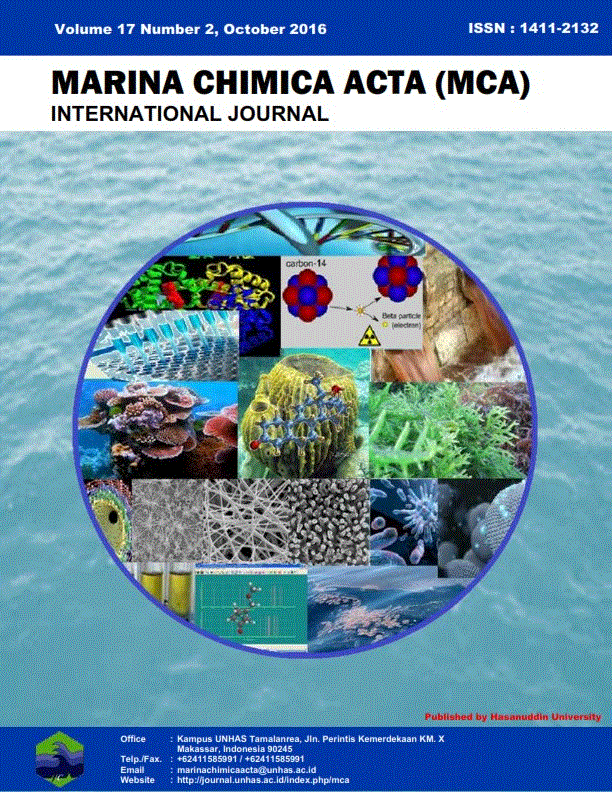EFFECT OF HEATING AND STORAGE TIME LEVELS 5- (Hydroxy Methyl) furan-2- KARBALDEHIDA (HMF) IN HONEY ORIGIN MALLAWA
Abstract
A research has been on determining the origin of forest honey quality Mallawa Maros based on the levels of 5-(hydroxymethyl)furfural-2-karbaldehida (HMF)is quantitatively based on the variation of heating temperature and duration of storage with White spectrophotometric method. The results showed that the levels of forest honey HMF origin Mallawa on heating temperature 35°C,90°C and 110°C respectively is 42.2023 mg/Kg, 46.0274 mg/Kg and 62.2520 mg/Kg. While the storage duration for 3,4, and 5 months had higher levels of HMF each 27.4309 mg/Kg, 42.5158 mg/Kg and 48.9405 mg/Kg. Heating temperature and storage time a big influence on levels of HMF and show a strong relationship to the water content, pH and free acid, reducing sugar content and diastase enzyme activity. Based on the research results, levels of HMF at the heating temperature of 110oC has passed the standards set by the SNI (up to 50 mg/Kg). Whereas the standard set by IHC for honey originating from thetropics (80 mg/ Kg)References
Achmadi, S., 1991, Analisis Kimia Produk Lebah Madu dan Pelatihan Staf Laboratorium Pusat Perlebahan Nasional Parung Panjang, Fakultas Matematika dan Ilmu Pengetahuan Alam, Institut Pertanian Bogor
Ajloun, S. dan Sujirapinyokul, P., 2010,Hydroxymethylfurfuraldehyde and amylase contents in Australian honey, Food Chem, 119 (2): 1000-1005.
Badan Standarisasi Nasional Indonesia. 2004. SNI-01-3545-2004 : Madu, Badan Standarisasi Nasional Indonesia, Jakarta.
Badan Standarisasi Nasional Indonesia, 2013, SNI nomor 3545:2013, Badan Standarisasi Nasional Indonesia, Jakarta.
Bogdanov, S., Ruoff K., and Persano K.O., 2004, Physico-Chemical Methods For The Charactehsation Of Unifloral Honeys A Review, Apidologie, 35 (2):4-17.
Bogdanov, S., Martin, P., dan Lullman, C., 2011, Honey as Nutrient and Food Function Food, Bee Product Science.
Codex Alimentarius Commission, 1989, Codex Standards of Sugars (honey). Esriche, I., Visquert, M., Carot, J.M. dan Domenech, E., Fito, P., 2008, Effect of Honey Thermal Condition on HMF Formation, Food Chem, 81(1):569-573.
Fallico, B., Zappala, M., Arena, E. and Verzera, A., 2004, Effect of Heating on Chemical Composition and HMF Level in Sicillian Monofloral Honey, Food Chemistry, 85(3):305-313.
International Honey Commision, 2002, harmonised method of the international honey commission, Switzerland.
Kesic, A., Crnkic, A., Hodzic, Z., Ibrisimovic, N., and Sestan, A., 2014, Effects of Botani Origin and Ageing on HMF Content in Bee Honey, J. of Scientific Research and Reports, 3(8); 1057-1066.
Mahmud,A., 2008. Pengembangan Lebah Madu Dalam Rangka Gerakan Pembangunan Masyarakat Di Provinsi Sulawesi Selatan. Dinas Kehutanan Provinsi Sulawesi Selatan, Jurnal Hutan Dan Masyarakat, 3(1) : 100-110.
Makawi, S. Z. A., Taha, M. I., Zakaria, B. A., Siddig, B., Mahmod, H., Elhusein, A.R. and Kariem, E. A. G., 2009, Identification and Quantification of HMF in Some Sugar-Containing Food Product by HPLC, Journal of Nutrition, 8(9)1391-1396.
Sutami, A., 2003,Pengaruh waktu penyimpanan dalam refrigerator terhadap komposisi kimia madu asli dan madu palsu Skripsi Jurusan Ilmu Produksi Ternak, Fakultas Peternakan, IPB, Bogor.
Tosi, E., Ciappini, M., Lucero, H., 2002,Honey thermal treatment effect on hydroxymethylfulfural content, Food Chem, 77(2): 71-74.
Turhan, I., Tetik, N., Korhan, M., Gurel, F., Reyhan, Tavukcuoflu, H., 2008, Quality of Honey Influenced by Thermal Treatment, LWT Food Sci and Tech, 41(1):1396-1399.

